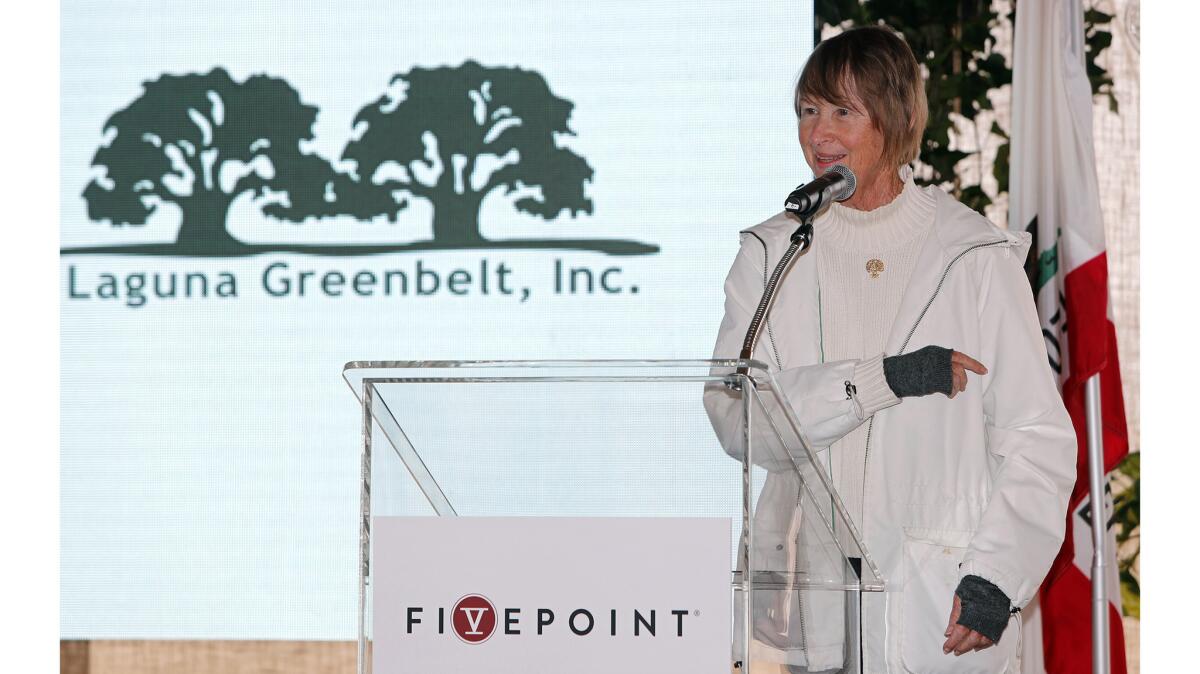Laguna Greenbelt president Elisabeth Brown steps down after 30 years of making Orange County greener
- Share via
Elisabeth Brown remembers when Laguna Greenbelt first struck out to save the canyon as developers threatened to overtake the land that the organization’s founder, James Dilley, called the “buckle of the Greenbelt.”
“We felt, as a neighborhood, that we were kind of endangered and we had some pretty active people on our board,” Brown said. “I was over there [with Laguna Greenbelt] one day, schlepping papers with Jon Brand, who was then president, and Harry Huggins ... and they said, ‘Why don’t you join the board?’ And, so I did, right when things were beginning to heat up about the canyon.”
Brown, a biologist and science writer by trade, was first appointed president of the organization in 1985. Though she’s held that position on and off throughout the years, Brown has now stepped down from her role as president of Laguna Greenbelt to focus her efforts elsewhere in the organization.
She will be succeeded on an interim basis by Norm Grossman, who has been on the board since 1984 and served most recently as a vice president.
“For 30 years, Elisabeth has been synonymous with the Greenbelt. No one person can replace her, it will take the entire board to fill her role,” Grossman said. “Moving forward, my goals are to see a functioning wildlife corridor in existence and the Laguna Greenbelt as the recognized protector of open spaces and all that make them special.”
Brown said that though she is stepping down from her role as president, that does not mean she will be leaving the board. She intends to work on the wildlife corridor project.
“If they let me, I will stay in the corridor group until it’s done,” she said.

“It’s like a half-time or full-time job and after a while, ... a group of us who were really the ones who started working on getting the wildlife corridor [study], we looked at each other and thought, ‘We’re now 70. This is hard work,’ ” Brown said, laughing. “We probably need more energy that we don’t have and some younger people and, hopefully, they pick up where we left off.”
Grossman will serve as president as the board considers candidates that could fill the position long-term, a news release by the organization said.
Brown was honored Thursday by the organization and community members at the board’s annual meeting at the Neighborhood Congregational Church. Councilwoman Toni Iseman and Mayor Pro Tem Steve Dicterow were also present to give Brown a certificate of recognition from Assemblywoman Cottie Petrie-Norris (D-Laguna Beach) and a city proclamation on the behalf of Mayor Bob Whalen.
“[Brown] can be very nice to the people that I didn’t like much at all,” Iseman joked. “And they would listen to her and things happened because she had the right temperament and you can’t mess with her brain. I want to thank you personally,” she said to Brown. “I don’t think the town would be the same without you.”
Brown initially joined the organization in 1980 to learn about the natural history of the area after having moved to Laguna Beach with her husband in the 1970s. At the time, Brown was writing for newspapers on the subject.
“We knew we were going to be in a fight for the canyon and I realized if I wanted to talk about the natural history, it needed to be saved,” Brown said.
“If you’re talking about open space, you have to have some. The threat at the time for the canyon was that we were going to lose the open space and that was what [Dilley]’s work was all about,” she said. “That’s how I got into it — I always wanted to translate [science] for people who could then enjoy it, understand it and then themselves turn it over to the next generation to do the same thing.”
Brown described her role with the organization as that of an educator, pointing to her work on the field guide published by the organization and a brochure that she wrote for people who lived in neighborhoods adjacent to the Laguna Coast Wilderness Park, which was dedicated in 1993.
Her proudest accomplishment, she said, was the field guide, which she said helped volunteer naturalists in the park.
“Removing the people who were living in Crystal Cove State Park from the public land, too; there was a big deal about that,” Brown said, “to get the trailer parks out of that park. It puts a big smile on my face every time I drive by. ‘Look at what’s not there.’”
Brown said the wildlife corridor project released its findings in September.
The study, conducted between 2016 to 2018, studied the wildlife corridor connecting Laguna Coast Wilderness Park and the Cleveland National Forest. It found that human activity at the corridor was impeding movement by animals.
If wildlife is unable to pass through the corridor, it could lead to reduced resources and eventually to inbreeding depression, in which recessive and possibly harmful genes become more prominent due to a lack of genetic diversity in the population, Megan Lulow, director of operations for the UC Irvine Natural Reserve System, said in October.
“It’s like a necklace. If you cut one bead out of the necklace, then the whole thing falls apart. We have to be sure that everything works. All the animals can get through,” Brown said. “Right now, we’re not there ... as long as the land is broken up into pieces, we will work to put them back together.”
“I’m just hoping it won’t be as hard,” she said. “It’s a good group now that’s working on the corridor. We picked up a few new people and I’m impressed by what they can do. I’m still gonna do that. It would be fun to do a column again, but that would depend on everything else.”
All the latest on Orange County from Orange County.
Get our free TimesOC newsletter.
You may occasionally receive promotional content from the Daily Pilot.






